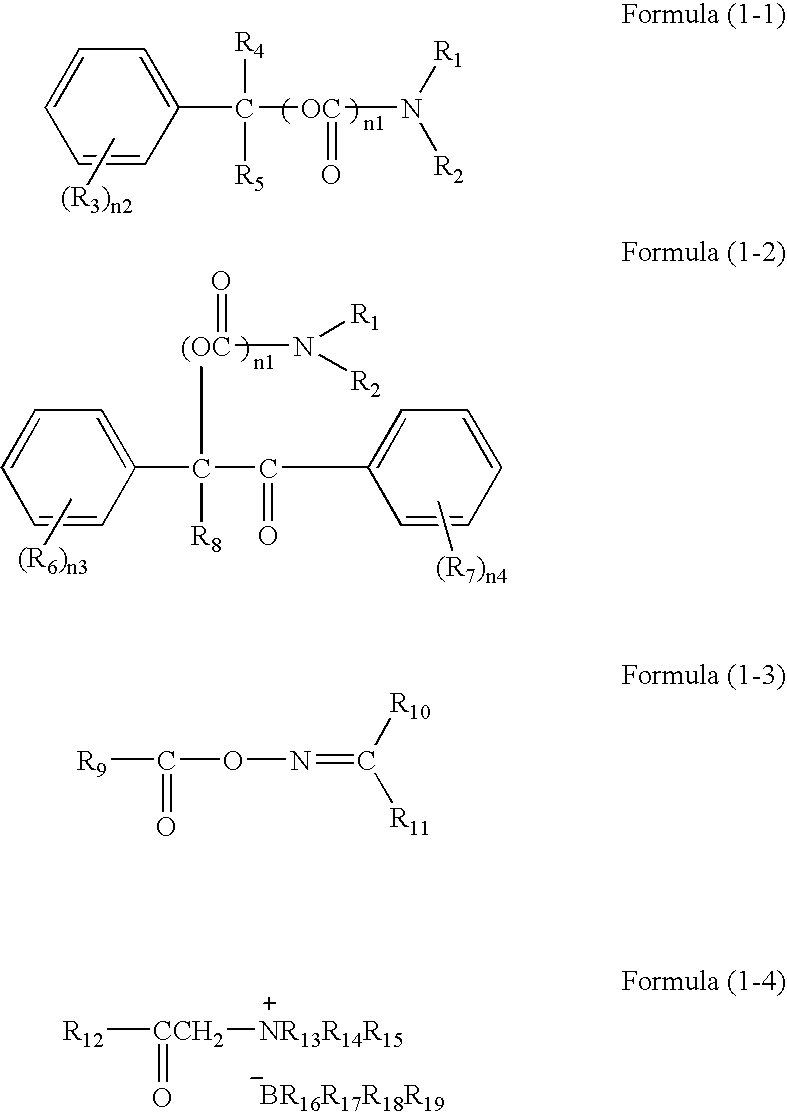However, among such known recording materials for the volume phase hologram, no material is not yet known to satisfy all the requirements, particularly in the application for a high-sensitivity high-resolution full-color three-dimensional display, and improvements are being desired.
More specifically, the bichromate-
gelatin system has advantages of a high
diffraction efficiency and
low noise characteristics, but is associated with drawbacks of a very poor storability, a necessity of a wet
processing and a low sensitivity.
Also the bleached
silver halide system has an
advantage of a high sensitivity, but is associated with drawbacks of requiring a wet process involving a cumbersome bleaching process, and a poor light fastness.
The photorefractive
system has an
advantage of being rewritable, but is associated with drawbacks of requiring a high
electric field at the recording, and a poor storability of recording.
The photochromic
polymer system, represented for example by an
azobenzene polymer material, also has an
advantage of being rewritable, but is associated with drawbacks of an extremely low sensitivity and a poor storability of
record.
However, such system involves drawbacks of a poor sensitivity of about 1 / 1000 in comparison with the bleached
silver halide system, a necessity for a heat fixing treatment as long as almost 2 hours for improving the
diffraction efficiency, an inhibition by
oxygen of the involved
radical polymerization, and a shrinkage of the recording material after
exposure and fixation thereby resulting in a change in diffraction
wavelength and angle at the reproducing operation, and further improvements are being desired.
However, in an existing two-dimensional optical recording medium such as DVD-R, a storage capacity is limited to about 25 GB at maximum because of the physical principle even if a short
wavelength is employed for recording and
reproduction, and a sufficiently large recording capacity capable of meeting the future demand cannot be anticipated.
In particular, the requirement of (1) high sensitivity is chemically contradictory to those of (3) high
diffraction efficiency, (4) dry process, (6)
low shrinkage after recording and (7) satisfactory storability, and it is difficult to satisfy these requirements at the same time.
For example, the bleached
silver halide system has a high sensitivity, but is generally unsuitable for a high-density recording material as it required a wet process.
Also it involves a soft film which is insufficient in storability.
On the other hand, WO No. 9744365A1 discloses a rewritable hologram recording material utilizing an
anisotropy in
refractive index and an alignment control in an
azobenzene polymer (photochromic polymer), but such material is far from practical use because of an extremely low sensitivity as it has a low
quantum yield in the
isomerization of
azobenzene and involves an alignment control, and also of a poor storability of
record as a trade-off of rewritability.
Also the rewritability is often undesirable because the record may be erroneously erased.
Also JP-A-5-80309 discloses a method of sandwiching a composition constituted of a binder polymer, a polymerizable
liquid crystal monomer having a
refractive index anisotropy and a photopolymerization initiator between transparent conductive films, and applying an
electric field to the partially cured composition thereby reversibly controlling presence / absence of reflection, but such method involves drawbacks of a necessity of
electric field application and a poor record storability and is unapplicable, because of its principle, to an optical recording medium or a display hologram (3D imaging), requiring recording of arbitrary information in an arbitrary location.
The aforementioned trade-off between a high sensitivity and a satisfactory storability and a
low shrinkage, and the limitation in the
multiplex recordability are difficult to avoid, because of the physical laws, within the photopolymer system involving the
material transfer.
Also the known systems utilizing the alignment control of the
liquid crystalline compound cannot meet the requirements of the optical recording medium in the sensitivity and the storability.
 Login to View More
Login to View More  Login to View More
Login to View More 


